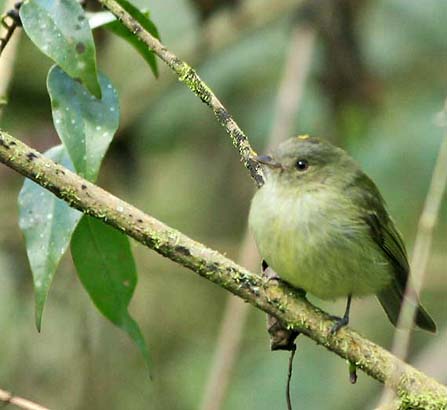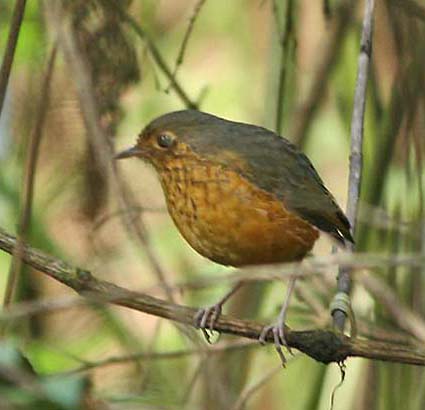TRIP LIST 3–6 Aug 2010
ITATIAIA NATIONAL PARK
White-faced Whistling-Duck Dendrocygna viduata: on pond checked in route to park
Dusky-legged Guan Penelope obscura: conspicuous daily (10-20/day)
Least Grebe Tachybaptus dominicus: on pond checked in route to park
Cattle Egret Bubulcus ibis: several in Giant Snipe valley
Turkey Vulture Cathartes aura: several outside park, only one inside park
Black Vulture Coragyps atratus: a few daily
Roadside Hawk Buteo magnirostris: one inside park
White-tailed Hawk Buteo albicaudatus: one circling over heights at end of Algulhas Negros road
Black Hawk-Eagle Spizaetus tyrannus: one in flight main hotels area
Southern Caracara Caracara plancus: at edge of park
Yellow-headed Caracara Milvago chimachima: at edge of park
Slaty-breasted Wood-Rail Aramides saracura: daily at Hotel Donati pond vicinity
Common Moorhen Gallinula chlropus: at pond checked enroute to park
Wattled Jacana Jacana jacana: at pond checked enroute to park
Southern Lapwing Vanellus chilensis: one in Giant Snipe valley
Great Snipe Gallinago undulata:
superb experience: one approached very closely in marsh and observed in
courtship flights, two more heard in distance. This subspecies [gigantea] is the largest snipe in the world, and basically looks double the size/weight of any other snipe
Picazuro Pigeon Patagioenas picazuro: common daily
Plumbeous Pigeon Patagioenas plumbea: one seen along Algulhas Negros road, Edson heard more
Gray-fronted Dove Leptotila rufaxilla: one seen along Algulhas Negros road
White-eyed Parakeet Aratinga leucophthalma: seen daily at edge of park
Maroon-bellied Parakeet Pyrrhura frontalis: regular in main hotel forests
Blue-winged Parrotlet Forpus xanthopterygius: small flocks in main hotel forests
Scaly-headed Parrot Pionus maximiliani: a couple daily in main hotel forests
Squirrel Cuckoo Piaya cayana: one only, main hotel area
Tawny-browed Owl Pulsatrix koeniswaldiana: pair seen at Hotel Donati grounds at night, responding to tape
Scale-throated Hermit Phaethornis eurynome: singles daily
Black Jacobin Florisuga fusca: male regular at Norma’s feeder, and a few others
Plovercrest Stephanoxis lalandi: we visited a very impressive lek along Algulhas Negros road that had a dozen or more males
Violet-capped Woodnymph Thalurania glaucopis: regular at hotel feeders
White-throated Hummingbird Leucochloris albicollis: regular at hotel feeders
Versicolored Emerald Amazilia versicolor: two seen during brief visit to Norma’s feeder
Brazilian Ruby Clytolaema rubricauda: regular at hotel feeders
Black-eared Fairy Heliothryx auritus: one inside forest in main hotel area
Surucua Trogon Trogon surrucura: singles inside forest on two days
Black-throated Trogon Trogon rufus: one in forest, main hotel area
Red-breasted Toucan Ramphastos dicolorus: heard daily, several seen in main hotel forests
Saffron Toucanet Pteroglossus bailloni: patchy but several seen, including at Hotel Ype
White-barred Piculet Picumnus cirratus: a couple in main hotel forests
Yellow-fronted Woodpecker Melanerpes flavifrons: a few seen in main hotel forests
White-spotted Woodpecker Veniliornis spilogaster: one along Algulhas Negros road
Green-barred Woodpecker Colaptes melanochloros: single bird on final day
Olivaceous Woodcreeper Sittasomus griseicapillus: a few daily in forest flocks
Planalto Woodcreeper Dendrocolaptes platyrostris: several seen, including at Hotel Ype
Lesser Woodcreeper Xiphorhynchus fuscus: one with mixed flock, main hotel forests
Scaled Woodcreeper Lepidocolaptes squamatus: seen twice along trails in main hotel forests
Araucaria Tit-Spinetail Leptasthenura setaria: pair seen atop Araucaria trees along Algulhas Negros road, responding to tape
Itatiaia Thistletail Oreophylax moreirae: pair in upper elevation scrub, end of Algulhas Negros road
Chicli Spinetail Synallaxis spixi: several seen in open scrub in main hotel area; Edson heard more
Pallid Spinetail Cranioleuca pallida: a few seen in open scrub in main hotel area; Edson heard more
Ochre-breasted Foliage-gleaner Philydor lichtensteini: one seen in mixed flock, main hotel forests
Black-capped Foliage-gleaner Philydor atricapillus: one seen in mixed flock; main hotel forests
White-collared Foliage-gleaner Anabazenops fuscus: noisy and easier to see than most foliage-gleaners, particularly in bamboo patches in main hotel forests
Sharp-billed Treehunter Heliobletus contaminates: several with mixed flocks, both in main hotel area and along Algulhas Negros road
Streaked Xenops Xenops rutilans: one with mixed flock in main hotel forests
Giant Antshrike Batara cinerea: heard most days and a pair seen in large bamboo patch near Hotel Donati
Large-tailed Antshrike Mackenziaena leachii: female in shrubbery at Hotel Ype our final day; Edson heard others
Variable Antshrike Thamnophilus caerulescens: heard most days, at least one seen
Rufous-capped Antshrike Thamnophilus ruficapillus: pair in upper elevation scrub, end of Algulhas Negros road
Rufous-backed Antvireo Dysithamnus xanthopterus: one in mixed flock along Algulhas Negros road
Rufous-winged Antwren Herpsilochmus rufimarginatus: one seen poorly in main hotel forests
Ferruginous Antbird Drymophila ferruginea: we worked long and hard with two pairs in bamboo near Hotel Donati to get views and photos
Rufous-tailed Antbird Drymophila genei: two pairs seen Algulhas Negros road
Streak-capped Antwren Terenura maculate: hard-to-see canopy species, but eventually decent views were obtained along bamboo trail
White-bibbed Antbird Myrmeciza loricata: male called in with tape for good view, main hotels area
Speckle-breasted Antpitta Hylopezus nattereri:
down in a deep gully off Algulhas Negros road, Edson knew a regular
location. We spent an hour sitting in one spot, playing tape and
watched other species, before the antpitta finally approached and set
itself in a thicket to call in full view
Slaty Bristlefront Merulaxis ater:
one seen nicely with tape in main hotel forests (but could not be
photo’d); Edson says this one sounds different than the Intervales
birds, and could be a separate species
Serra do Mar Tapaculo Scytalopus notorious: a recent split from Mouse-colored Tapaculo S. speluncae,
Edson says this might be split further as the Itatiaia birds sound
different than those at Intervales. We saw one here in main hotels
forest
Such's Antthrush Chamaeza meruloides:
we worked with two birds with Edson’s tape inside forests in main
hotels area, and saw both; the one along bamboo trail was seen better
on our final day
Brazilian Antthrush Chamaeza ruficauda: one seen in response to tape along Algulhas Negros road
Gray-hooded Flycatcher Mionectes rufiventris: one in mixed flock along Algulhas Negros road
Sepia-capped Flycatcher Leptopogon amaurocephalus: a couple daily in main hotel forests
Southern Antpipit Corythopis delalandi: one seen with tape in main hotel forests, along a steep-stepped trail
Brown-breasted Bamboo-Tyrant Hemitriccus obsoletus: one seen well, more heard, along Algulhas Negros road
Ochre-faced Tody-Flycatcher Poecilotriccus plumbeiceps: one along Algulhas Negros road
Yellow-lored Tody-Flycatcher Todirostrum poliocephalum : one at scrub edge at abandoned Hotel Simon
Greenish Tyrannulet Phyllomyias virescens: one in mixed flock along Algulhas Negros road
Planalto Tyrannulet Phyllomyias fasciatus: a couple in mixed flocks in main hotel forests
Gray-capped Tyrannulet Phyllomyias griseocapilla: singles on two days in mixed flocks
Southern Beardless-Tyrannulet Camptostoma obsoletum: one seen at Hotel Donati, more heard
White-crested Tyrannulet Serpophaga subcristata: one in high elevation scrub at end of Algulhas Negros road; another in scrub at abandoned Hotel Simon
Yellow Tyrannulet Capsiempis flaveola: one seen nicely along bamboo trail
Mottle-cheeked Tyrannulet Phylloscartes ventralis: at least 3 seen along Algulhas Negros road
Serra do Mar Tyrannulet Phylloscartes difficilis: a tiny tyrannulet that we spent a lot of time trying to see decently along Algulhas Negros road; we had at least 4 there
Yellow-olive Flycatcher Tolmomyias sulphurescens: at least 3 in main hotel forests; very different bird than elsewhere in Neotropics
White-throated Spadebill Platyrinchus mystaceus: a couple in main hotel forests
Cliff Flycatcher Hirundinea ferruginea: three around abandoned Hotel Simon each visit there
Tropical Peewee Contopus cinereus: one at abandoned Hotel Simon; very dark race here
Blue-billed Black-Tyrant Knipolegus cyanirostris: male at Hotel Simon, the very different female seen at Hotel Donati
Velvety Black-Tyrant Knipolegus nigerrimus: a few seen daily, all elevations
Long-tailed Tyrant Colonia colonus: a couple perched around abandoned Hotel Simon
Social Flycatcher Myiozetetes similis: a few daily
Great Kiskadee Pitangus sulphuratus: just one in this park
Sirystes Sirystes sibilator: one seen from balcony of Hotel Ype
Short-crested Flycatcher Myiarchus ferox: a couple in main hotel forests
Large-headed Flatbill Ramphotrigon megacephalum: one seen very well, in response to tape, in bamboo patch on bamboo trail
Sharpbill Oxyruncus cristatus: singles heard at Hotel Ype, and around Hotel Donati
Bare-throated Bellbird Procnias nudicollis: female perched during drizzle in bamboo patch near Hotel Donati
Black-and-gold Cotinga Tijuca atra:
we had great experiences with 8 birds at “the bridge” along Algulhas
Negros road. Males were perched a long long way away at tip-top of tall
trees, but they eventually responded to tape and had them calling and
sitting around us
Cinnamon-vented Piha Lipaugus lanioides: one flew over us in forest near main hotels
Red-ruffed Fruitcrow Pyroderus scutatus: two seen in fruiting trees not far from Hotel Simon
Serra do Mar Tyrant-Manakin Neopelma chrysolophum: one perched near us for great views while we waited for antpitta to appear down in a gully along Algulhas Negros road
Black-capped Piprites Piprites pileata: small flock of a half-dozen seen well along Algulhas Negros road
Blue Manakin Chiroxiphia caudate: heard most days and two males finally seen in main hotel forests
Rufous-browed Peppershrike Cyclarhis gujanensis: heard daily in forest
Blue-and-white Swallow Pygochelidon cyanoleuca: one small flock overhead
Southern House-Wren Troglodytes [a.] musculus: a few around mail hotels
Yellow-legged Thrush Platycichla flavipes: small numbers daily around main hotels
Rufous-bellied Thrush Turdus rufiventris: a couple most days
Creamy-bellied Thrush Turdus amaurochalinus: Singer only
Bananaquit Coereba flaveola: regular daily in main hotels area
Magpie Tanager Cissopis leverianus: a few most days in main hotel forests
Olive-green Tanager Orthogonys chloricterus: common at hotel feeders
Black-goggled Tanager Trichothraupis melanops: common daily
Ruby-crowned Tanager Tachyphonus coronatus: a few daily
Sayaca Tanager Thraupis sayaca: a few here and there, main hotel vicinity
Golden-chevroned Tanager Thraupis ornate: just a couple at Ype feeder
Diademed Tanager Stephanophorus diadematus: two were attracted to breach thrown out at lunch along Algulhas Negros road; another was near main hotels
Green-headed Tanager Tangara seledon: common at main hotel feeders
Brassy-breasted Tanager Tangara desmaresti: small flocks at forest edge, all elevations
Gilt-edged Tanager Tangara cyanoventris: two came to Norma’s bird bath during a brief visit, three more were in mixed canopy flock along Algulhas Negros road
Burnished-buff Tanager Tangara cayana: a few recorded in main hotel forests
Swallow-tanager Tersina viridis: Singer had one fly by at Hotel Donati
Blue Dacnis Dacnis cayana: occasional at Hotel Ype feeders
Rufous-headed Tanager Hemithraupis ruficapilla: two in main hotel forests; Edson heard more
Rufous-collared Sparrow Zonotrichia capensis: common
Red-rumped Warbling-Finch Poospiza lateralis: a small party along Algulhas Negros road
Great Pampas-Finch Embernagra platensis: one attracted to bread thrown out at lunch along Algulhas Negros road
Double-collared Seedeater Sporophila caerulescens: a pair regularly in Hotel Ype garden
Thick-billed Saltator Saltator maxillosus: three along Algulhas Negros road
Ultramarine Grosbeak Cyanocompsa brissonii: one female at forest edge at Hotel Donati
Masked Yellowthroat Geothlypis aequinoctialis: singing male near Hotel Simon posed well
Golden-crowned Warbler Basileuterus culicivorus: common in undergrowth flocks
White-rimmed Warbler Basileuterus leucoblepharus: pairs here and there, all elevations
Red-rumped Cacique Cacicus haemorrhous: regular at Hotel Ype feeders
Golden-winged Cacique Cacicus chrysopterus: good numbers at Hotel Ype feeders and in garden
Shiny Cowbird Molothrus bonariensis: one male near Hotel Donati
Hooded Siskin Carduelis magellanica: three along Algulhas Negros road
Chestnut-bellied Euphonia Euphonia pectoralis: a few regular at Hotel Ype feeders
Blue-naped Chlorophonia Chlorophonia cyanea: a few regular at Hotel Ype feeders
Common Waxbill Estrilda astrild: non-native introduction, Tenney only, near Hotel Ype
Heard/seen by guide. Fortunately, most of these were seen by at least some of us at Intervales: Variable Screech-Owl Megascops atricapilla [we heard this bird but as a potential lifer for all of us, it does not appear on our main list], Planalto Hermit Phaethornis pretrei, White Woodpecker Melanerpes candidus, Robust Woodpecker Campephilus robustus [another potential lifer heard in the distance], Gray-bellied Spinetail Synallaxis cinerascens, Buff-browed Foliage-gleaner Syndactyla rufosuperciliata, Sharp-tailed Streamcreeper Lochmias nematura, Star-throated Antwren Myrmotherula gularis, Plain Antvireo Dysithamnus mentalis, White-shouldered Fire-eye Pyriglena leucoptera, Rufous Gnateater Conopophaga lineata, Variegated Antpitta Grallaria varia, Fork-tailed Tody-Tyrant Hemitriccus furcatus, Rough-legged Tyrannulet Phyllomyias burmeisteri, Whiskered Flycatcher Myiobius barbatus, Shear-tailed Gray Tyrant Muscipipra vetula, Boat-billed Flycatcher Megarynchus pitangua, Chestnut-crowned Becard Pachyramphus castaneus, Gray-breasted Martin Progne chalybea, White-necked Thrush Turdus albicollis, Chestnut-headed Tanager Pyrrhocoma ruficeps, Buffy-fronted Seedeater Sporophila frontalis [potential lifer], Temminck's Seedeater Sporophila falcirostris [potential lifer], Black-throated Grosbeak Saltator fuliginosus, and Green-winged Saltator Saltator similis.
MAMMALS
Distant titi-monkeys were heard, and a couple South American Coati Nasua nasua were seen. |

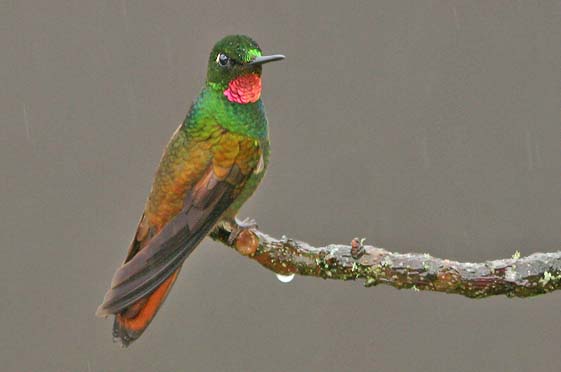 It
was unfortunate that our short 3 day visit to Itatiaia National Park,
in Rio de Janeiro State, Brazil, coincided with a spell of cold rainy
weather. The famed forests were often hidden in fog and gloom (Dusky-legged Guan out our balcony, above). We stayed at Hotel Ype
with its lovely chalets and fireplaces in the rooms (below right). Even
on the gloomiest of days one could stand on the balconies (with jackets
on) and either watch the feeders or take photos of birds passing
through the grounds (Chris Tenney, below left).
It
was unfortunate that our short 3 day visit to Itatiaia National Park,
in Rio de Janeiro State, Brazil, coincided with a spell of cold rainy
weather. The famed forests were often hidden in fog and gloom (Dusky-legged Guan out our balcony, above). We stayed at Hotel Ype
with its lovely chalets and fireplaces in the rooms (below right). Even
on the gloomiest of days one could stand on the balconies (with jackets
on) and either watch the feeders or take photos of birds passing
through the grounds (Chris Tenney, below left). 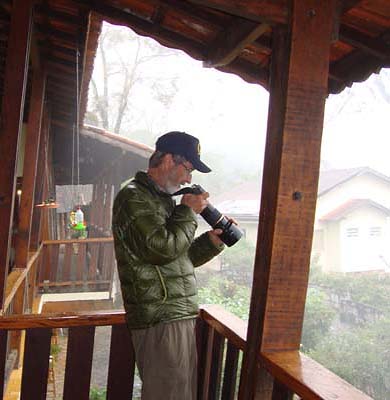
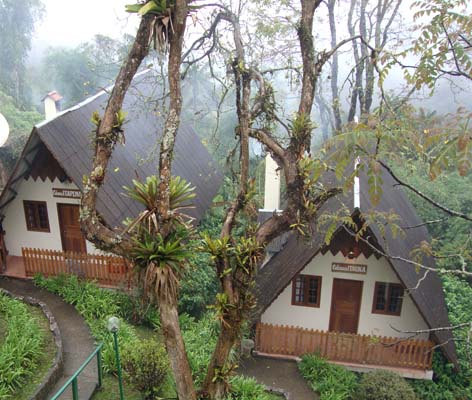
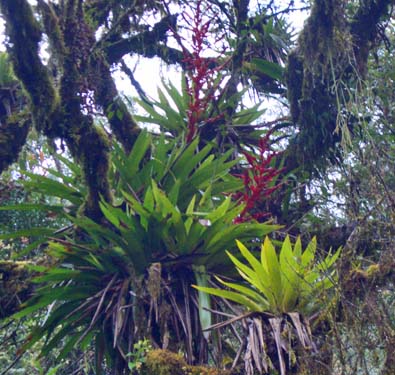
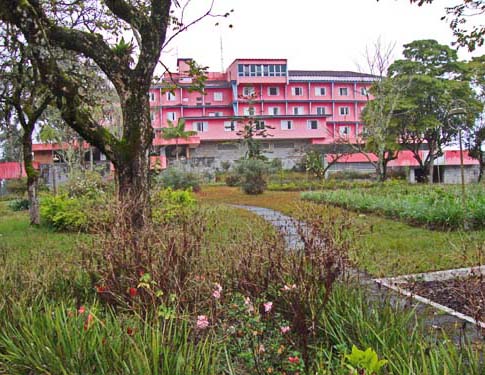
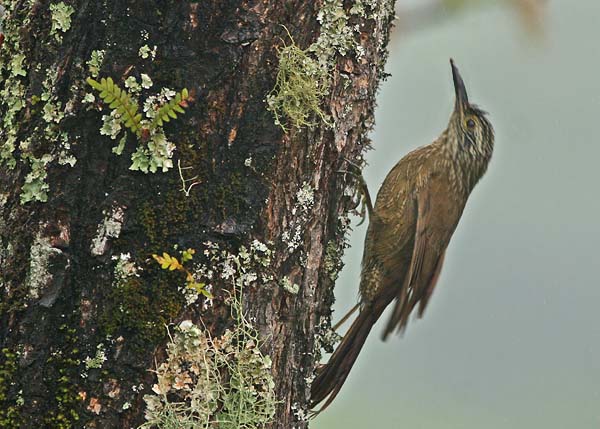 There
is also an odd gloomy feel around the park itself, and not just because
there were epiphytes everywhere (above left). Changing management
philosophies have led to potholed roads, abandoned trails, and the
bankruptcy of the Simon Hotel. The latter now stands as a huge pink
ruin on a hill surrounded by forest, giving the aura of Kubla Khan's
lost Xanadu (above right).
There
is also an odd gloomy feel around the park itself, and not just because
there were epiphytes everywhere (above left). Changing management
philosophies have led to potholed roads, abandoned trails, and the
bankruptcy of the Simon Hotel. The latter now stands as a huge pink
ruin on a hill surrounded by forest, giving the aura of Kubla Khan's
lost Xanadu (above right). 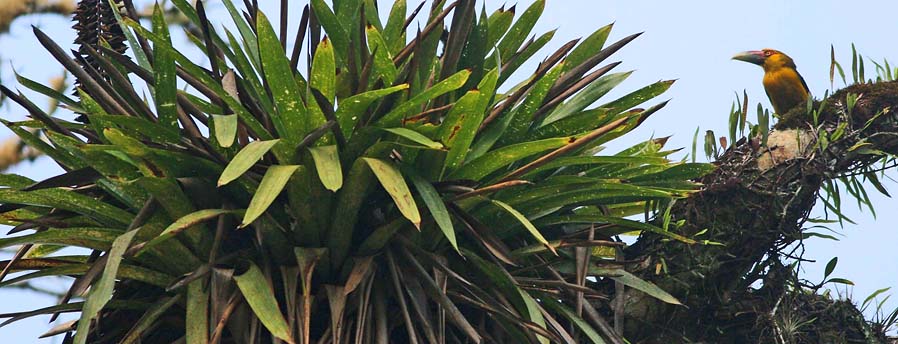
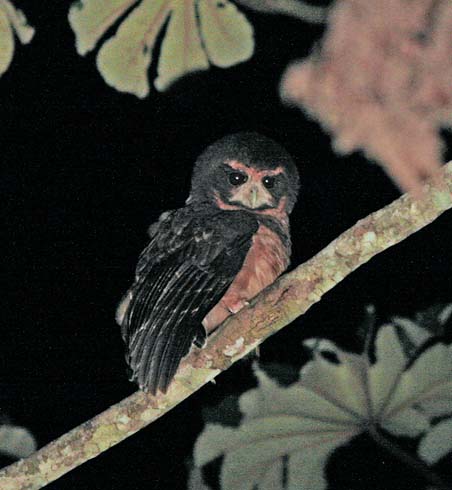
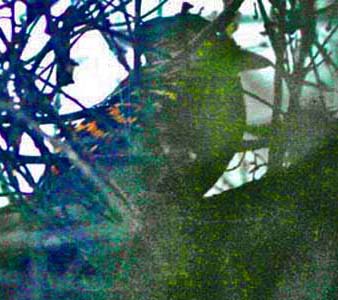
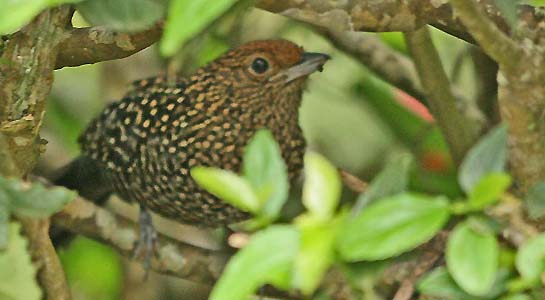
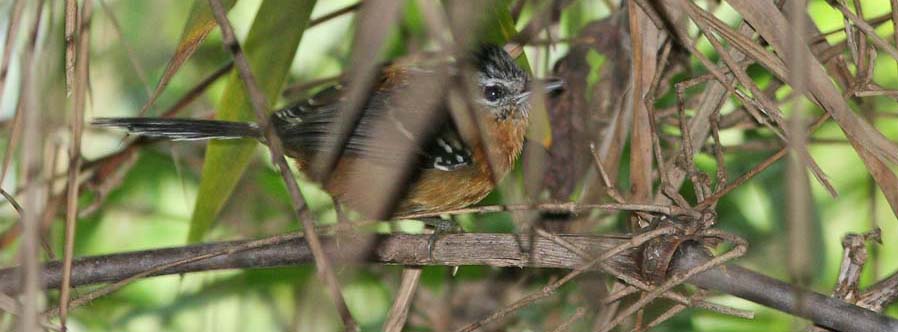

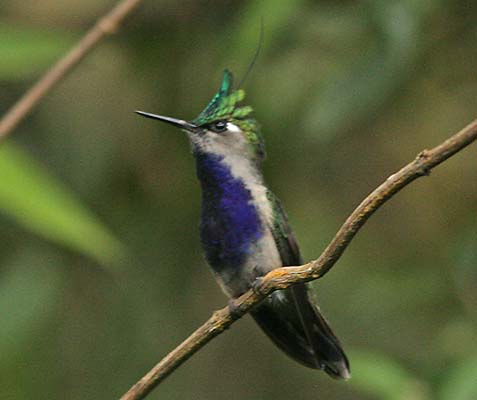 On
5 August, which turned out to be our only really nice weather day at
Itatiaia, Chris, Dan & Don got up early for a trip to the higher
elevations of Itatiaia NP along Algulhas Negros Road
(above). Here we birded cloud forest and alpine scrub between
1800–2400m [5900–7900 ft.], well above the main hotel area at 500–800m
[1640–2600 ft.]. Here the air was crisp and cool and we enjoyed
spectacular views from parts of the dead-end road.
On
5 August, which turned out to be our only really nice weather day at
Itatiaia, Chris, Dan & Don got up early for a trip to the higher
elevations of Itatiaia NP along Algulhas Negros Road
(above). Here we birded cloud forest and alpine scrub between
1800–2400m [5900–7900 ft.], well above the main hotel area at 500–800m
[1640–2600 ft.]. Here the air was crisp and cool and we enjoyed
spectacular views from parts of the dead-end road. 

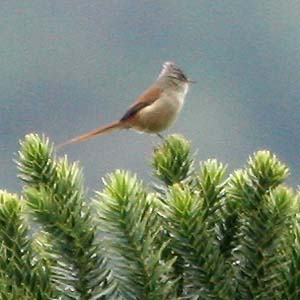
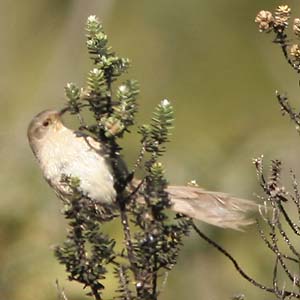
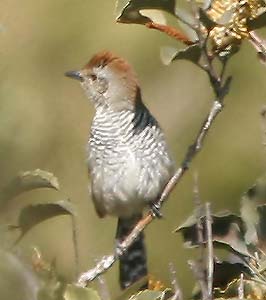
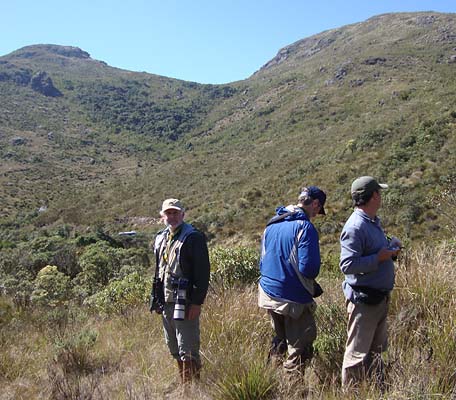 At
2400m on Algulhas Negros Road the cloud forest is left behind and the
habitat became thick 'alpine' scrub (right). This habitat was occupied
by several local endemics, including Itatiaia Thistletail (above middle) and Rufous-capped Antshrike (female, above right). Another odd habitat along the road was a small patch of Araucaria conifers, complete with an endemic bird, Araucaria Tit-Spinetail (above left).
At
2400m on Algulhas Negros Road the cloud forest is left behind and the
habitat became thick 'alpine' scrub (right). This habitat was occupied
by several local endemics, including Itatiaia Thistletail (above middle) and Rufous-capped Antshrike (female, above right). Another odd habitat along the road was a small patch of Araucaria conifers, complete with an endemic bird, Araucaria Tit-Spinetail (above left). 